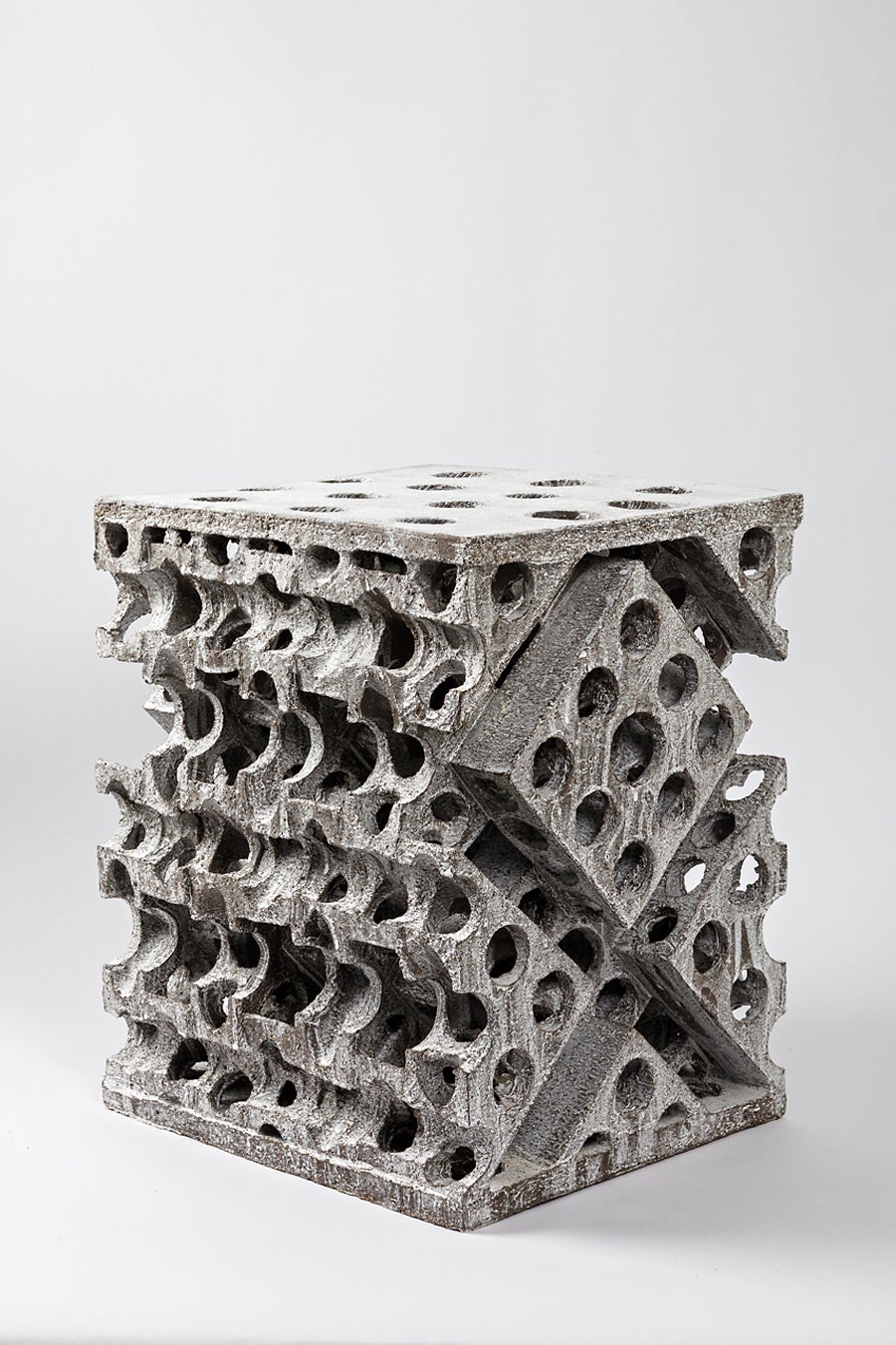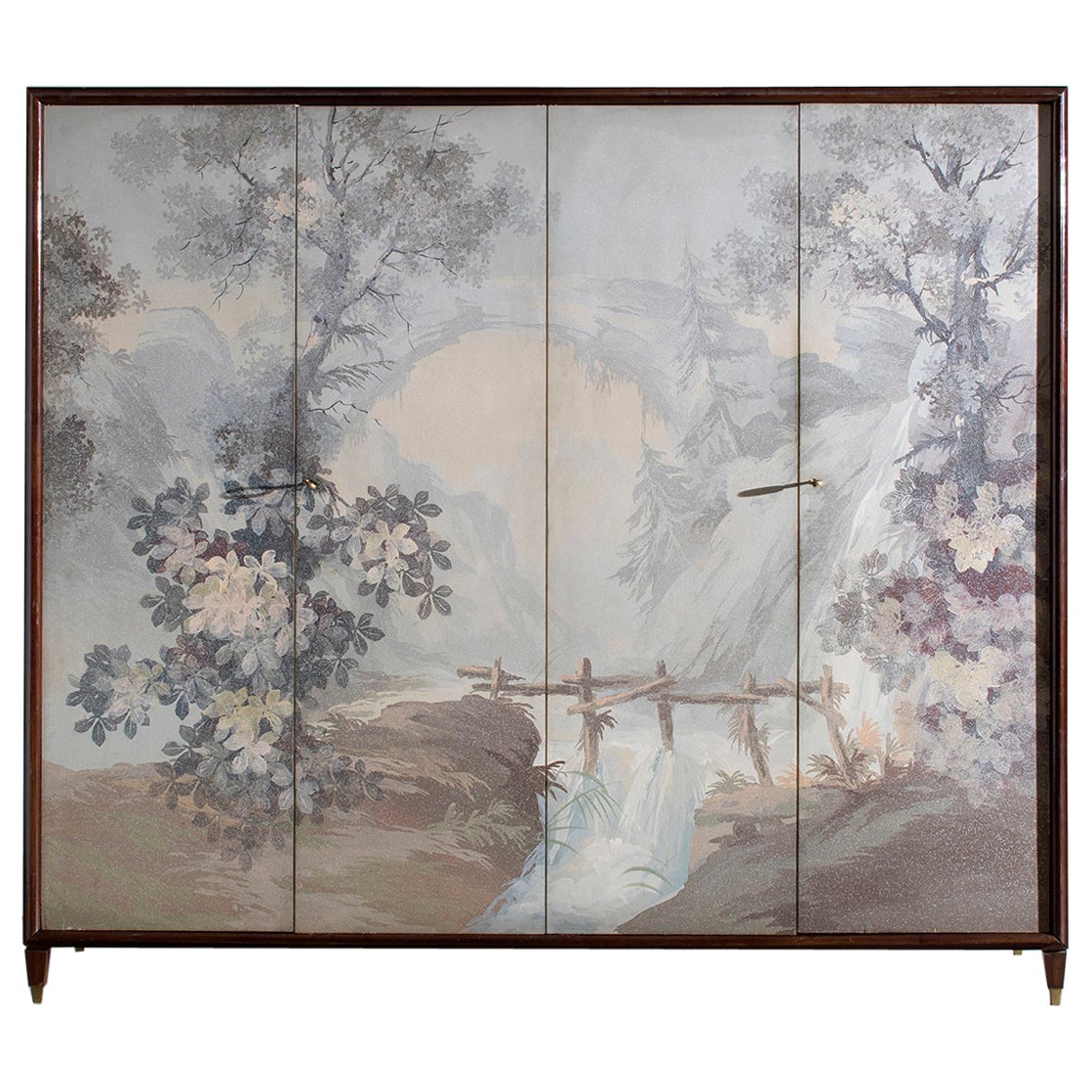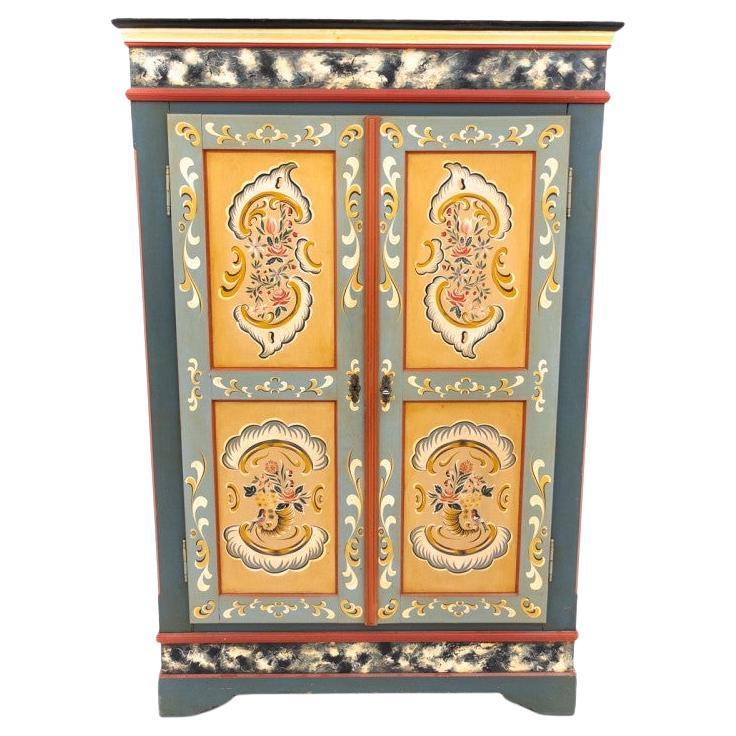Items Similar to Important Wardrobe of the Hansen Republics
Want more images or videos?
Request additional images or videos from the seller
1 of 8
Important Wardrobe of the Hansen Republics
About the Item
IMPORTANT WARDROBE OF THE HANSEAN REPUBLICS
ORIGIN : NORTHERN GERMANY
PERIOD : LATE 16th – EARLY 17th CENTURY
Height : 222 cm
Width : 198 cm
Depth : 78 cm
Lacquered and gilded oak wood
This imposing wardrobe is punctuated by three corinthian pilasters, carved with foliage and flowers framing a central female figure and rests on three ball feet.
It opens with two leaves and has two drawers in the base. The decoration of these two elements is formed of identical but inverted “diamond points”.
It was in Hamburg that the imposing straight cornices developed in the 16th century, while the broken pediments were preferred in Lübeck and in Danzig the curvilinear cornices.
At the beginning of the 17th century, it was oak that was favored by cabinet makers, walnut soon replaced it, alternating with ebony. Here you can admire inside, the finesse of the fonçures worked on oak wood originating from Hungary.
- Dimensions:Height: 87.41 in (222 cm)Width: 77.96 in (198 cm)Depth: 30.71 in (78 cm)
- Materials and Techniques:
- Period:
- Date of Manufacture:Late 16th - Early 17th Century
- Condition:Replacements made. Repaired. Wear consistent with age and use. Minor losses. Minor structural damages. Minor fading.
- Seller Location:Saint-Ouen, FR
- Reference Number:1stDibs: LU3115336026322

About the Seller
5.0
Vetted Seller
These experienced sellers undergo a comprehensive evaluation by our team of in-house experts.
Established in 2016
1stDibs seller since 2017
153 sales on 1stDibs
Typical response time: 7 hours
- ShippingRetrieving quote...Ships From: Paris, France
- Return PolicyThis item cannot be returned.
More From This SellerView All
- Important Renaissance Cabinet from Lyon 'France' with a Decor of PerspectivesLocated in Saint-Ouen, FRAs soon as 1540 France's second Renaissance is in the making, intimately linked to the rediscovery of the Antique world. The development of the printing and engraving industry allows the spread of artworks and models in many cities and countries. The Italian influence can be perceived in every artistic field. While the French king entrust the most talented Italian artists with major projects such as Il Rosso or Primaticcio in Fontainebleau, French artists also travel to Italy to form themselves to this new style. In Italy they get acquainted with the work of Leo Battista Alberti the first to theorize perspective (De Pictura, 1435-36) and architecture (De re oedificatoria, 1541). Those two publications would have a revolutionary impact on arts. Furniture is marked by the work of the most famous Italian architects of the time as well as French architects. Indeed Philibert de l'Orme competes with Alberti and by the end of his life publishes several treaties including one devoted to a theory of architecture (1567). Unfortunately he would not live to complete the second volume. In this treaty he expresses his interest for mathematical norms applied to architecture, copied from the Antique. His journeys in Italy allowed him to accumulate the most sophisticated references. Jean Bullant, another architect of great talent also theorizes his practice. He establishes rules characterizing Greco-Roman art staying faithful to Vitruvius. Following this new inspiration the structure of furniture evolves. From then on appear columns, capitals, cornices, friezes and architraves. The ornamentation uses this inspiration as well with egg-and-dart, palm leaf and rose adorning the most beautiful pieces. In Lyon, crossroad where meet merchants from everywhere those new experiments are welcomed. Lyon florishing printing industry allows the spreading of models and treaties essential to the artist's work. Thus the first publication of Vitruvius' De Architectura in France would be printed in Lyon in 1532. Artists from Lyon rediscover and familiarize themselves with the Antique knowledge very early. They adopt those new ideas and use them in their own creations. Lyon cabinet-makers re interpret Antique architecture and Italian Renaissance palaces to give their pieces a pure and harmonious architectural structure. Grooved pilasters are particularly favored. They are topped by capitals of diverse orders always respecting the sequencing with simpler ones for the lower levels and the richest ones on the higher levels. As for the ornamentation, one of the great distinctiveness of Lyon workshops remains the architectural perspective illusions, drawing inspiration from Tuscany. True masterpiece of the Second French Renaissance this important cabinet illustrates Lyon workshops' taste for fine Italian architecture inspired by Antiquity. An architectural perspective of great quality is treated in symmetry on each panel. This two-bodied cabinet without recess stands on four rectangular feet. The base comprises a molding, a palm leaf frieze and is bordered by a braid. The lower body is divided by three grooved pilasters with Tuscan capitals framing two door-leaves. The two panels are encircled by a moudled frame with palm leaves. They are finely carved with a decor of fantasized architecture depicting an Italian Renaissance palace erected symmetrically on each side of a grooved pilaster. On the ground floor a door opens through a stilted arch while the stories are opened with mullioned windows, dormers and occuli. Two large pegged-boss cladded pillars support the entablature enriched by a palm leaf frieze upon which stands an arch whose coffered intrados is centred by a rose. Behind this arch a pyramid appears, standing in front of a second facade with a window topped by a broken curvilinear pediment under a cul-de-four with a shell. The checker flooring gives depth to the low-reliefs creating vanishing points structuring the panels and guiding the eye of the observer. A thin laurel braid highlights the belt of the cabinet where are located two drawers. Their facades are adorned by palm leaves in hoops. The upper body is encircled with palm leaves. The same ternary division as in the lower body appears. However, the pilasters are topped by Ionic capitals with volutes and egg-and-dart. The door-leaves are framed with flowers. On the panels the artist has designed another architectural decor. On the foreground open two arches on top of grooved pilasters with rectangular capitals adorned with palm leaves. The arches are enriched with braids and the coffered intrados bears a decor of roses. The spandrels also bear a flower decor. In the background another arcature hosts a fluted grooved column topped with double basket acanthus capital, characteristic of Corinthian order. The triangular pediment is interrupted by a choux bourguignon. A large cornice crowns the cabinet. It stands on pilasters and forms an entablature comprising a palm leaf frieze and an egg-and-dart, triglyph and palm leaf cornice. The cabinet's sides have also been carefully considered. The lower body's panels are enriched with an arch rising above a broken pediment portico hosting a twisted column. Flowers garnish the spandrels. An architectural facade completes the decor. The upper body's panels present two arches supported by a facade opened with dormers and mullioned windows as well as cartouches (one bears the inscription 1580 dating the cabinet) suggesting the interior of an Italian Renaissance palace, confirmed by the chandeliers. The flooring leads our gaze to a second arch with a broken curvilinear pediment where stands a flower vase. This arch opens onto a perspective of another facade along a road. Inside the cabinet, on the lower body door-leaves appear two designs. On the right door is depicted a Crucifixion. Saint Mary and Saint John flank the Christ on the cross. In the bottom part is inscribed « Dure uiator abis nihil haec spectacula curas / Pendenti cum sis unica cura Deo. / Tota suo moriente dolet natura Magistro. / Nil qui solus eras caussa dolenda doles. ». The signature [Christoff Swartz Monachiensis pinx[it] / Ioa[nnes] Sadeler sculp[it]] tells us it was made by Johan Sadeler I (1550-1600) after Christoph Schwartz (1548-1592). This engraving belongs to an ensemble depicting the Passion of Christ Johan Sadeler executed in 1589 after an altar piece painted by Christoph Schwartz for the private chapel of Renée of Loraine, wife of Duke William V of Bavaria. This altar piece made of nine copper panels has been destroyed during the 19th century. The Crucifixion panel once in the centre of the altar piece is the only one that survived and is today kept in Munich's Alte Pinakothek. On the left door appears Saint Francis receiving the stigmata. The inscription says : « Signastidomine Servum Tuum. Franciscum. Signis Redemptionis Nostrae ». This Renaissance cabinet with an architectural decor appearing as much in the structure faithful to Antique rules...Category
Antique 16th Century European Renaissance Cabinets
MaterialsWalnut
- Renaissance Palace Wardrobe with Perspectival ViewsLocated in Saint-Ouen, FRA rare carved walnut wardrobe opening with four door-leaves and two drawers in the lower part. The doors bear architectural views in low reliefs, fluted pilasters and Ionic capitals. Upper Body Two door-leaves with carved architectural perspectives open the wardrobe framed by three fluted pilasters with Ionic capitals. Each door-leaf depict two semi-circular arcades whose cornice and base shows a central vanishing point. Likewise the pavement’s lines act for the artisan as a way to create depth. The vaulting instead leads us to think the vanishing point has to be situated where the handle is, between the two complementaries reliefs. The elegant moulded belt hides an internal secret space, accessible through a moveable plank in the upper body. Lower Body Two door-leaves identical to those of the upper body framed by three fluted pilasters with Doric capitals. The base of the wardrobe opens with two large drawers. The sides also bear panels depicting architectural perspectives. The external pilasters share their Ionic capital with the facade’s pilasters. Thus we can observe on the wardrobe’s sides the capital’s lateral parts with the elegant volute specific to the Ionic order. This palace wardrobe is topped by an overlapping cornice standing on three consoles for the facade and two consoles on each sides. Placed right above the pilasters each console are adorned by fully expanded leaves. During the 15th century a major interest for architecture and perspective studies arises and influences patrons tastes. The work of great theorists such as Leon Battista Alberti...Category
Antique 16th Century Italian Renaissance Wardrobes and Armoires
MaterialsWalnut
- 17th Century Emblazoned Germanic ArmoireLocated in Saint-Ouen, FRThis interesting oak cabinet of germanic workmanship is a wedding furniture. The cabinet rests on a molded base, opens with two doors located on e...Category
Antique 17th Century German Other Wardrobes and Armoires
MaterialsOak
- 16th Century Cabinet with Knights Carving from Avignon Workshops 'France'Located in Saint-Ouen, FRCollection Jean Thuile Around the mid-sixteenth century French furnishing evolves in its conception and ornamentation. The start of major archi...Category
Antique 16th Century French Renaissance Cabinets
MaterialsWalnut
- French Renaissance Cabinet with PerspectivesLocated in Saint-Ouen, FRThis Renaissance Cabinet reveals the great mastery of the Lyon workshops which are at the origin of its realization. Sculptors and wood-carvers worked here in symbiosis to express an...Category
Antique 16th Century French Renaissance Cabinets
MaterialsWalnut
- Gothic Revival Apothecary CabinetLocated in Saint-Ouen, FRWooden apothecary cabinet with carved decoration in neo-Gothic style. The capitals are carved with Baphomets holding two figures by the hair for one and fantastic birds for the other...Category
Early 20th Century European Gothic Revival Wardrobes and Armoires
MaterialsOak
You May Also Like
- Important Burr & Burl Gothic Antique Wardrobe Oversized Polished Brass FittingsLocated in GBWe are delighted to offer for sale this very rare and important, Museum quality, Gothic style Antique Burr & Burl Walnut wardrobe with oversized, polished brass fittings This piece is part of a suite, I have the matching dressing table listed under my other items I have never seen another wardrobe like this in my career, it has a Gothic castle look and feel to it, the timber panels are way older than the actual wardrobe, I think this was made in the Victorian era by repurposing something that was very old and making something newer and usable, the fixtures are fittings all look to be mid-17th century circa 1740-1760, the timber I would say is around the same era but the internals are pure Victorian circa 1860-1880 Inside you have a large campaign chest...Category
Antique 19th Century European Gothic Wardrobes and Armoires
MaterialsBrass
- Midcentury Wardrobe from the 1960sLocated in Roma, RMMidcentury wood wardrobe with doors and shelves from the 1960s.Category
Vintage 1960s Italian Wardrobes and Armoires
MaterialsWood
- Wooden Wardrobe in the syle of Arredamenti Borsani Varedo from the 1950sBy Arredamenti BorsaniLocated in Roma, RMWooden wardrobe in the style of Arredamenti Borsani Varedo from the 1950s Product details Wooden cabinet with tempera decoration. Dimensions: cm 194H×221L×62D.Category
Vintage 1950s Italian Wardrobes and Armoires
MaterialsBrass
- Wardrobe in the Taste of Pierre Gautier Delaye, France, 1950sBy Pierre Gautier-DelayeLocated in Saint Ouen, FRCabinet in pine and black lacquered wrought iron, France 1960's.Category
Vintage 1950s French Mid-Century Modern Wardrobes and Armoires
MaterialsWrought Iron
- Unique, Massive Wardrobe from the 2nd Half of the 18th CenturyLocated in Opole, PLUnique, Massive Wardrobe from the 2nd Half of the 18th Century We present you a three-leaf piece of furniture with two drawers in the bottom section ...Category
Antique Late 18th Century European Wardrobes and Armoires
MaterialsWood
- Wardrobe, Western Europe, first half of the 20th century.Located in Chorzów, PLWardrobe from the first half of the 20th century. Furniture in very good condition. Dimensions: 193 cm / width 127 cm / depth 52 cmCategory
Vintage 1920s German Wardrobes and Armoires
MaterialsWalnut
Recently Viewed
View AllMore Ways To Browse
Wardrobe 16th
Used Wardrobe
Wardrobe Oak Antique
30 Armoire
18th Century Walnut Antique Armoire
Compendium Wardrobe
Victorian Gentlemans Dresser
Pink Lacquer Wardrobe
Plan Jasper Morrison
Robson Stool
18th Century Mahogany Armoire
French French Wardrobe Cabinet
Bedroom Clothes Cabinet
Southwest Armoire
Danish Wardrobe Sliding Doors
Ico Parisi Wardrobe
Alpine Wardrobe
Farmhouse Armoire





